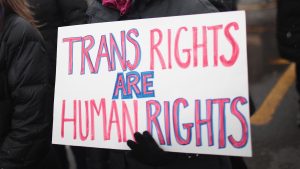June Transgender Science Numbers
A bunch of new numbers from transgender science in June! There have been some recent updates and new numbers of interest to me. Most represent good news but some are dark. At least you should know about them.
2.3% is the frequency of adolescents declaring themselves to be transgender in the U.S. population. This is from a recent analysis of data from Centers for Disease Control surveys (Turban, J. et al. ) This is consistent with several school surveys across the country in the past two years.
1.6 Million people in the United States are transgender. The number comes from a recent Williams Institute study of CDC survey data. This is probably a low estimate because of the methods of collection. Only 16 of 50 U.S. states participated and land-line survey calling was used. They extrapolated based on demographics to get this number. The Williams Institute estimates have been steadily rising over the past 5 years. The real number may actually be closer to 3 Million. Using the surveys of Lynn Conway which showed at least 1% of natal males are transgender and assuming parity with those assigned females at birth.
42% know someone who is transgender up from 37% in 2017. That is good news as the percentage has continued to climb for several years. The survey was conducted by the Pew Foundation. 53% of 18-29 age group know someone who is transgender while the percentage is 32% in the age group 65 or older. We win over one person at a time. Remember that you are an ambassador for all transgender people.
6 transgender movements. In June I added a new movement to the 5 that I previously identified. There are 4 organic ones begun by transgender people. The 4 home-grown organic transgender movements are MTF transsexual, crossdresser, FTM transsexual and indigent street transgender. The fifth movement I previously identified is the religious recruiting movement. The religious recruiting movement seeks to acquire new members by encouraging transgender people to join up and to show their tolerance for transgender people to get non-transgender people to join up. One of the reasons that religious organizations have lost membership is intolerance to LGBT people but they sometimes only pay lip service to transgender acceptance, hoping to change the behavior of a target individual.
 In June, I added the Reified Applied Post-Modernist (RAPOMO) “woke” movement as the 6th transgender movement because it pretends to be organic to transgender people but it is not. It has ulterior motives. It tries to interact with the other movements but it is a separate initiative. This movement is out of the work of Gayle Rubin, Judith Butler, Eve Kosofsky, Eve Sedgewick and Michel Foucault but actually dates back into the 19th Century. It seeks to undermine U.S. culture in order to gain political power. This movement is using transgender people as token minorities to voice criticism of Western culture. Their base philosophy is Critical Theory which consists of being critical of all facets of Western culture in order to tear down U.S. society. They have no intention of improving things and, if history obtains from their predecessors, transgender people will be some of the first to feel the lash for non-conformity. Recently, organizations that previously advocated for transgender people have turned “woke” including NCTE, the ACLU and the Southern Poverty Law Center. The RAPOMO should be considered dangerous and their actions counterproductive to transgender progress. It is bound to other facets of critical theory by intersectionalism — the ring that “in the darkness bind[s] them” (after Tolkien).
In June, I added the Reified Applied Post-Modernist (RAPOMO) “woke” movement as the 6th transgender movement because it pretends to be organic to transgender people but it is not. It has ulterior motives. It tries to interact with the other movements but it is a separate initiative. This movement is out of the work of Gayle Rubin, Judith Butler, Eve Kosofsky, Eve Sedgewick and Michel Foucault but actually dates back into the 19th Century. It seeks to undermine U.S. culture in order to gain political power. This movement is using transgender people as token minorities to voice criticism of Western culture. Their base philosophy is Critical Theory which consists of being critical of all facets of Western culture in order to tear down U.S. society. They have no intention of improving things and, if history obtains from their predecessors, transgender people will be some of the first to feel the lash for non-conformity. Recently, organizations that previously advocated for transgender people have turned “woke” including NCTE, the ACLU and the Southern Poverty Law Center. The RAPOMO should be considered dangerous and their actions counterproductive to transgender progress. It is bound to other facets of critical theory by intersectionalism — the ring that “in the darkness bind[s] them” (after Tolkien).
400 genes found to have different configurations for transgender people versus non-transgender people in a genome-wide scan (GWAS). This is out of 100,000 genes in the human genome. 30 of these genes are currently being studied intensively because they are involved in forming brain structures previously identified as being different in transgender people .
34 seconds average duration of orgasm in transgender women after starting hormone therapy as opposed to 9 seconds before hormone therapy. Trans women report experiencing orgasm triggered by other places on their bodies after the start of hormone therapy.
20% of transgender youth attempt suicide. 33%’s homes were gender affirming for transgender youth. 40% of transgender people attempt suicide. There are undoubtedly many who succeed but are not counted in these statistics. 60% of LGBTQ youth who wanted mental health counseling are unable to get it. These numbers are from a survey by the Trevor Project.
5.9% of transgender high school students report trading sex in a Minnesota survey as opposed to 1.2% for cisgender students. 75% of those engaged in sex trading had attempted suicide, compared with 30.1 % who did not engage. Those who engage in trading sex are more likely to report that they need mental health counseling.
 .5%-1.7% live births are intersex infants, depending on what anatomical and genetic configurations are included. It may actually be as high as 2%. The belief that a person must follow one of two developmental trajectories for anatomy and physiology is clearly unfounded. Multiple pathways exist. “Corrective” genital surgery is practiced far less than it used to be and now runs around .01-.02%.
.5%-1.7% live births are intersex infants, depending on what anatomical and genetic configurations are included. It may actually be as high as 2%. The belief that a person must follow one of two developmental trajectories for anatomy and physiology is clearly unfounded. Multiple pathways exist. “Corrective” genital surgery is practiced far less than it used to be and now runs around .01-.02%.
 64% believe that transgender people should be protected from discrimination in jobs, housing and public accommodations. 38% say society has gone too far in accepting trans people, while a roughly equal percentage say society has not gone far enough. About 25% say we have it about right. 44% said that science has influenced them.
64% believe that transgender people should be protected from discrimination in jobs, housing and public accommodations. 38% say society has gone too far in accepting trans people, while a roughly equal percentage say society has not gone far enough. About 25% say we have it about right. 44% said that science has influenced them.
1.5/1 ratio is the ratio of adolescent trans girls to trans boys. This ratio is lower than previous found ratios in 2017 and 2019, indicating that social contagion is not responsible for adolescents becoming transgender. This refutes the notion that Rapid Onset Gender Dysphoria (ROGD) exists among trans girls.
So, there you have it—the numbers from June to keep you up to date.
Category: All TGForum Posts




